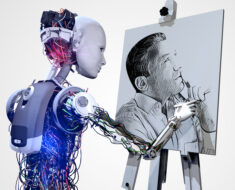The sleek, futuristic silhouette of a driverless car glides down the highway, its headlights piercing the twilight like robotic eyes. Inside, passengers tap away on tablets, lost in their own digital worlds, oblivious to the silent symphony of algorithms and sensors orchestrating their journey. This is the tantalizing vision of a future promised by autonomous vehicles – a world free from traffic jams, accidents, and the tyranny of the steering wheel. But as we inch closer to this reality, a crucial question looms: what ethical quandaries lie hidden in the gears of this technological marvel?
The Trolley Problem on Four Wheels:
Imagine a driverless car hurtling towards a group of pedestrians. Suddenly, a glitch throws it off course. Two options remain: slam into the pedestrians, or swerve onto the sidewalk, potentially injuring a cyclist. This nightmarish scenario, a modern twist on the classic trolley problem, exemplifies the ethical tightrope autonomous vehicles must walk. Who programs the car’s moral compass? Should it prioritize the safety of passengers, pedestrians, or even itself? Each choice carries the weight of human lives, and the burden of responsibility falls not on a fallible driver, but on the cold, calculating logic of algorithms.
The Algorithmic Bias:
But algorithms, like their creators, are not immune to bias. Training data for AI systems can reflect the prejudices of the real world, potentially leading to discriminatory outcomes. Imagine a scenario where a self-driving car, programmed to prioritize efficiency, consistently avoids routes through low-income neighborhoods, perpetuating existing social inequalities. Addressing algorithmic bias requires not just technical expertise, but also a deep understanding of social justice and a commitment to equitable transportation systems.
The Privacy Paradox:
Driverless cars are data-guzzling behemoths, collecting information on everything from our routes and destinations to our vital signs and emotional states. This raises serious concerns about privacy. Who owns this data? How is it used? Can it be weaponized against us? Balancing the potential benefits of data-driven transportation with the right to privacy is a delicate dance, requiring robust regulations and transparent data governance practices.
The Human Cost of Progress:
The rise of driverless cars could usher in an era of unprecedented efficiency and safety. But it also carries the potential for significant job displacement, particularly in the transportation sector. Taxi drivers, truck drivers, and even parking attendants could face unemployment, exacerbating existing economic inequalities. Mitigating these negative impacts requires thoughtful social safety nets, retraining programs, and a commitment to ensuring that the benefits of technological progress are shared equitably.
Charting the Ethical Course:
Navigating the ethical minefield of driverless cars demands a multi-pronged approach. Robust regulations that prioritize safety and fairness are essential. Developers must prioritize ethical considerations throughout the design and development process. Open and transparent communication with the public is crucial to build trust and acceptance. And perhaps most importantly, we must engage in a broad societal conversation about the values we want to embed in the very fabric of our transportation systems.
The future of driverless cars is not set in stone. It is a path we pave with each decision, each line of code, each ethical debate. By approaching this transformative technology with a clear-eyed understanding of its potential pitfalls and a unwavering commitment to doing the right thing, we can ensure that the road ahead leads not just to a more efficient future, but also a more just and equitable one.
As we grapple with the ethical dilemmas of driverless cars, it’s important to remember that technology is not a moral compass. It is a tool, and like any tool, its value depends on the hands that wield it. Let us use this powerful tool wisely, shaping a future where the gleaming chrome of autonomous vehicles reflects not just technological prowess, but also the enduring values of humanity.





